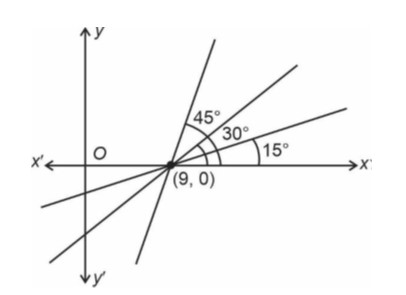A point P moves so that the sum of squares of its distances from the points (1, 2) and (-2, 1) is 14. Let f(x, y) = 0 be the locus of P, which intersects the x-axis at the points A , B and the y-axis at the points C, D. Then the area of the quadrilateral ACBD is equal to:
A point P moves so that the sum of squares of its distances from the points (1, 2) and (-2, 1) is 14. Let f(x, y) = 0 be the locus of P, which intersects the x-axis at the points A , B and the y-axis at the points C, D. Then the area of the quadrilateral ACBD is equal to:
Option 1 -
Option 2 -
Option 3 -
Option 4 -
9
-
1 Answer
-
Correct Option - 2
Detailed Solution:Let point P : (h, k)
Therefore according to question,
locus of P(h, k) is
Now intersection with x – axis are
Now intersection with y – axis are
Therefore are of the quadrilateral ABCD is =
Similar Questions for you
Eqn : y – 0 = tan45° (x – 9) Þ y = (x – 9)
Option (B) is correct
|r1 – r2| < c1c2 < r1 + r2
->
Now,
(y – 2) = m (x – 8)
⇒ x-intercept
⇒
⇒ y-intercept
⇒ (–8m + 2)
⇒ OA + OB =
->
->
->
->Minimum = 18
Kindly consider the following figure
According to question,
Equation of required line is
Obviously B (2, 2) satisfying condition (i)
Taking an Exam? Selecting a College?
Get authentic answers from experts, students and alumni that you won't find anywhere else
Sign Up on ShikshaOn Shiksha, get access to
- 65k Colleges
- 1.2k Exams
- 678k Reviews
- 1800k Answers

